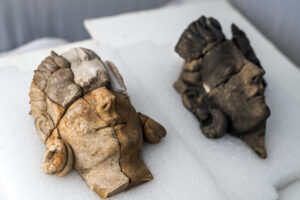Spain’s Higher Council for Scientific Research announced that researchers from the Institute of Archeology of Mérida (IAM-CSIC) working at the site of Casas del Turuñuelo (Badajoz) have uncovered the remains of five anthropomorphic reliefs from the 5th century BC, artifacts of the little known Tartessian culture that existed in Spain from the 8th to the 4th century B.C.
The announcement begins:
The works carried out within the framework of the V excavation campaign at the Tartessian site of Casas del Turuñuelo (Guareña, Badajoz) bring to light the remains of five figured reliefs from the V century BC, the first belonging to the Tartessian culture (8th century -IV BC). The discovery was made during the excavation of the eastern sector of the site, the area through which the patio of the building is accessed, where a massive sacrifice of animals , mainly horses, was documented. The unusual thing about the new finding is that the representations correspond to human faces.
The team from the Institute of Archaeology, a joint center of the Higher Council for Scientific Research (CSIC) and the Junta de Extremadura, led by Esther Rodríguez González and Sebastián Celestino Pérez , confirmed today at a press conference that, of the set recovered to date, two of the figurative reliefs are almost complete and correspond to two female figures adorned with outstanding earrings or earrings that represent typical pieces of Tartessian goldsmithing.


